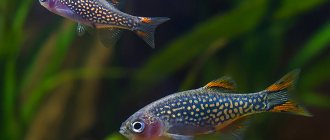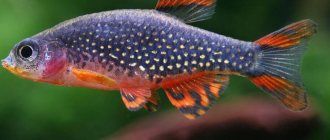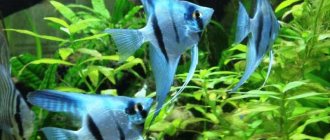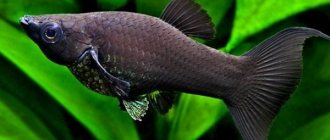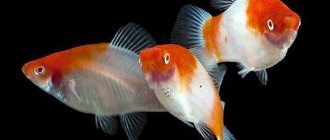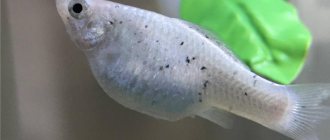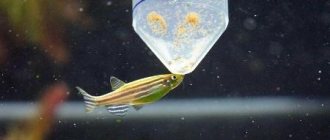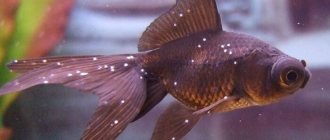Emerald microrasbora (Danio erythromicron) Annandale, 1918.
Synonyms
Russian: Danio Erythromicron, Microrasbora Tape, Rasbora Erythromicron, Emerald Danio Latin: Microrasbora erythromicron, Celestichthys erythromicron
Etymology
Celestichthys: From Latin caelestis meaning "celestial" and ichthys meaning "fish". Danio: Common name for small fish in India and Sri Lanka, from the Bengali dhani/dhani, meaning "rice field". erythromicron: From Ancient Greek (erythros), meaning "red", and (micron), meaning "small".
Family: Cyprinidae Genus: Danio
Range and Habitat
Southeast Asia, endemic to Inle Lake, Myanmar.
Native to the isolated mountainous Inle Lake and surrounding watershed in Shan State, eastern Myanmar, it is also found near the village of Loi Kaw in neighboring Kaya State to the south.
Inle Lake is located in a karst valley known as the Yanghoe Basin, located almost 900 m above sea level in the Shan Plateau region and is home to many endemic animals, including nine species of fish and numerous gastropods.
The water in Inle Lake is clean, shallow in depth (2-3 meters in most places), and has a very fertile, loamy substrate.
D. erythromicron mainly gathers along the edges of the lake, where grasses and reed-like plants grow.
Since the lake is located in a karst zone, it contains neutral or slightly alkaline water with a pH value in the range of 7.5-8.0.
Aquarium Basics
Microrasboras are not difficult to keep, however, when keeping them as pets, it would be useful to follow some recommendations:
- The dimensions of the aquarium should be selected based on the size of the flock, however, you should not crowd the Boraras at all. Thus, even small species (the body length of which is up to 2 cm) can only be housed in tanks with a volume of 30 liters or more (preferably at the rate of 1 liter of liquid per individual). Due to the jumping ability of fish, it is necessary to organize an upper ceiling for the tank.
- Environment parameters: temperature +20…+25 °C; hardness – 7 dH; acidity – 6.5-7.5 pH. A weekly change of a third of the water volume is required. Good filtration and aeration are necessary, however, while avoiding the formation of increased liquid fluidity. It is worthwhile to periodically clean the substrate thoroughly.
- Landscaping: Dense, providing plenty of cover, reducing open space to an average or minimum. Plants can be either floating or fixed in the ground. Shade-loving.
- Soft sandy substrate, the thickness of which is selected based on the characteristics of the algae, but not less than 3 cm.
- Decor: driftwood, small caves, stones, etc.
- Lighting: diffused, low intensity.
Behavior and Compatibility
A shy, but very beautiful schooling fish, so it is advisable to keep it in numbers of at least 10 individuals; it is most suitable for keeping in small aquariums.
The same tiny and peaceful species are suitable as neighbors for the dwarf rasbora. In addition, they become more confident in the presence of fish of similar size and living in the middle layers of water and near the surface. The best neighbors would be Espey's rasbora, Amanda's tetra, miniature characins and rainbow fish.
Gets along well with all types of peaceful and medium-sized fish. Rivalry usually occurs between dominant males. They can chase other members of the pack, but do without fights or injuries. When kept with larger and more active species, it will constantly hide. It is possible to keep them with shrimp, but only with adults, since they can eat babies.
Buy as many as possible from 20 or more, since with this quantity the fish are more active and less shy, more often visible and have better coloring.
Mr. Tail recommends: variety of species
Let's look at the most popular varieties of Microassembly.
Galaxy
Danio margaritatus. Rasbora Star. Galaxy.
Homeland: eastern Myanmar and northern Thailand.
Size: up to 3 cm.
Color: on a gray canvas there are many light tones of oval spots. The coloring of males is more intense, with clearly defined black and red lines on the fins (the tail is also divided by a transparent insert). Mature male individuals of the Galaxy have a red belly. There is a light stripe on the back that becomes bright during courtship. The body of the female is blue-green with dull speckles, the belly is white or milky. The body shape is more rounded, the sizes are larger.
Contents: from 20 fish.
Kubotai
Green Neon Rasbora. Kubotai.
Range: Myanmar and Thailand.
Up to 2 cm in length.
Color range: silver with a bright yellow-green tint. The fins are transparent.
Contents: in a group of about 10 individuals.
Erythromicron
Boraras Erythromicron. Emerald Dwarf Rasbora.
Size: 2.5-2.7 cm.
Color: a series of pale blue and pink (orange, cream with an emerald tint) tones of vertical stripes along the entire body. Honey-colored head. Red fins that become transparent or greenish at the ends. At the base of the tail there is a black irregular spot.
It is recommended to keep a flock of 20 individuals or more.
Gates
Burmese Gold.
Size – up to 3 cm.
Translucent body with a golden or silvery coating. Dark thin lateral line. The back, like the head, is strewn with many small black spots.
Contents: 8-10 individuals.
Rubescens
Red Dwarf Rasbora.
Size: 2 cm.
The color of the back ranges from gray to dark brown with a green tint. The sides of the body are orange. The belly is silvery. The fins are transparent.
Contents: school of 10 fish.
The species is listed in the Red Book.
Nana
1.5 cm in length.
The body is translucent with a malachite tint. The fin plumage is transparent.
Bridget (Brigitta)
Rasbora Mosquito. Brigittae.
Size: about 2 cm.
Color: dark back and belly. The sides are strawberry color. In the center of the body there are several horizontal elongated black spots on both sides.
Females are brighter and larger than males.
Measure
Merah.
Natural habitat - Kalimantan.
Size – up to 2 cm.
Coloring: on a light gray or golden background, large black or dark green oval-shaped spots with a bright red or orange border, located along the lateral line from the center of the body to the base of the tail. The gills are scarlet. The belly is light silver.
Microrasbora Mera prefers the upper and middle layers of the water column.
Maculat
Maculates.
Homeland: Malaysia, Kalimantan, southern Thailand.
The size of the fish is up to 2.5 cm.
The body is pale red with an orange coating. There is a large black round spot in the center of the body on both sides. Also two small irregular dark brown pigments at the anus and at the base of the tail. The fins are half red, the rest is transparent. The dorsal and anal have a black edging. The belly is light, pale pink.
Content difficulty: medium.
Prefers the upper layers of the water column.
Firefly
Rasbora Firefly. Boraras Firefly.
Area: Vietnam, Cambodia, Thailand.
Size: about 2 cm.
Color: on a light brown background there is a dark green thin stripe just below the lateral line. Above it is a golden border. The fins are transparent. The tail plumage is also decorated with a round black spot. The belly is light. Gill discs interspersed with cherry color.
Micro
Natural range: northeast of Thailand.
Fish up to 1.5 cm. Translucent with a pale golden hue. Similar to a firefly, but the color is more faded. Black spots are presented in the form of small scattering or absent.
It is recommended to keep fish of this variety in a group of 8-10 individuals.
Green Carplet
Glowing Carplet. Horadandia atukorali.
Homeland: freshwater and brackish water bodies of western Sri Lanka, southern India.
Size: up to 2 cm.
Golden color with green sheen.
Rasbora Spilocercus
Habitat in nature: Thailand, Laos.
Size: up to 3 cm.
On a silver background with a green tint, a line runs along the ridge from the head to the base of the tail, consisting of many small dots. At the base and branches of the tail feathers, as well as on the dorsal and anal transparent fins, there are black round large spots. The belly is clean and silvery. The gill discs have burgundy pigments.
Tinwini
Golden Rings. Spotted Burmese Danio
Homeland: Burma, upper basin of the Irrawaddy River.
Size: up to 3 cm.
Coloring: on a golden background there are many black round spots covering the entire body and transparent fins, without affecting only the silvery surface of the belly. Reminds me of the color of a leopard.
It is recommended to keep a school of 8-10 fish.
Dracula
Range: Northern part of Myanmar.
Size: about 1 cm.
Features: males have tooth-like processes in their mouths, some of which on the lower jaw are presented in the form of elongated fangs extending beyond the oral cavity.
Color: the head is covered with a golden coating, the rest of the body and fins are transparent. The insides are clearly visible.
A flock should be formed of 10 individuals or more.
Dadiburjora
Laubuka dadiburjori.
Homeland: western part of India.
The size of the fish is up to 3 cm.
Coloration: on a golden-orange background with a dark blue dashed line from the head to the base of the tail.
Contents: in a group of 10 fish.
Aquarium
The minimum basic aquarium dimensions are recommended from 60 * 30 cm, due to the sometimes aggressive behavior of dominant males.
The presence of densely planted plants is mandatory, as this is a shy fish. There should be free areas for swimming, which will also allow them to be observed. They look much brighter against the background of dark and shallow soil.
Too bright light scares the fish, so to dim it, you need to float floating plants on the surface of the water.
Water parameters:
Temperature: 22 - 27° C pH: 7.0 - 8.0 Hardness: 8 - 25° dGH
Filtration should be gentle, simulating the natural environment for micro-assay. Aeration and weekly water changes of about 30% are also necessary.
How to distinguish a female from a male?
Although sexual dimorphism in individuals of this species is very weakly expressed, it is still quite possible to distinguish a male from a female, especially during the mating season: in males the color becomes even more intense, and in females the body outlines are rounded and become larger.
In general, females are paler, smaller than males, and the pelvic fins of females are less colored. Males often swim around females, trying to court them and gain favor. They can even start “fights” among themselves.
Breeding
If the fish are in good condition, they will spawn frequently, and in a heavily planted, mature aquarium, a small number of fry may appear without your intervention.
However, if you want to increase the fry's numbers, a slightly more controlled approach is required.
To obtain fry in sufficient quantities, you will need a spawning tank of 10-20 liters, which can accommodate several pairs. For successful spawning, males and females are kept separately for several weeks, and the basis of nutrition during this period is live food.
The fish should be released into the spawning tank in the evening, first the females, then the males. The darkness helps them get comfortable, and in the morning, as a rule, spawning begins.
The female lays tiny amber eggs, no more than 1 mm in diameter, on moss, which must be immediately removed so that the producers do not eat the eggs and a new one placed in its place.
After a week, the adults are placed in a common aquarium.
Incubation is somewhat dependent on temperature, usually taking about 72 hours, and the fry begin swimming freely after 3-4 days.
The fry need to be fed when they begin to swim horizontally without sinking to the bottom. Starter food "live dust" - ciliates and rotifers, as well as specialized dry food intended for fry, then cyclops and artemia nauplii.
Fry that have reached 1 cm in length can be transplanted into a community aquarium.
If the necessary conditions are provided, it lives for about 3 years.
Feeding
Most varieties of Microrasbor are unpretentious in terms of nutrition, however, their diet must be balanced: combine both live and dry food. This will benefit not only health, but also the visual component: the color will become brighter and more saturated.
Used as food:
- ground mixtures or granules for carp;
- small insects;
- seaweed;
- nematodes;
- Daphnia;
- grindal;
- Artemia;
- small bloodworms, etc.
It is not recommended to resort to feeding flakes.
Notes
Previously, this species was included in the genus Microrasbora, although some authors, such as Kottelat and Witte (1999), have for some time placed it in the genus Danio.
Species such as D. erythromicron, D. margaritatus, D. choprae and D. flagrans were then revised and grouped into the genus Celestichthys Roberts, 2007. They have a unique body coloration consisting of vertical stripes (C. erythromicron, C. choprae, C. flagrans) or light spots (C. margaritatus) and have either very short antennae or none at all. The genus Celestichthys was founded by Roberts as a synonym of the genus Danio and confirmed (Kottelat, 2013).
Today, other scientists (Kullander 2015, Kullander and Britz 2015, Kullander et al. 2015, Zhang et al. 2016) have re-examined the genus Danio as a genus including the species Brachydanio and Celestichthys and in 2021 with the description of a new species of mini -danio - Danio htamanthinus used the genus Danio.
Important nuance
Another key point in keeping rasbora is that in an aquarium with them, the bottom should be covered with dry tree leaves.
The fact is that in the habitats of these species of Boraras, the bottom of reservoirs is covered with fallen leaves, branches, and snags. In some places the layer is so thick that the water becomes tea-colored and almost opaque.
And in others, the water depth is several centimeters, although to this day it is about a meter! All this space is filled with fallen leaves. As leaves and other plant debris decompose at the bottom, they become home to many different bacteria and microorganisms.
They also release tannins into the water, which reduce water hardness and pH, turning the water into something similar in color to tea. By the way, you can learn about using tree leaves in an aquarium from this article.
Inle Lake
The climate of Myanmar is characterized by the Indian Monsoon. There are three climatic seasons:
Summer, from March to mid-May Rainy season, from mid-May to late October Winter, from November to late February - early March
Inle Lake is located in the mountains of Shan State. This part of Myanmar is classified as subtropical, with moderate temperatures that are subject to seasonal variations. The lake extends from north to south for 22 kilometers with a width of up to 10. It is located at an altitude of 900 meters above sea level. In the dry season, the depth of the lake is no more than three to four meters; with the onset of monsoons, the water level rises by 1.30 meters.
The locals call themselves Intha, children of the lake. They originally lived in southern Myanmar. Due to constant wars with the neighboring country of Thailand and repression, they fled to the lake at the end of the 13th century and founded four settlements. From these four settlements the name of the lake arose, Inle - “lake of four”. Former refugees very quickly adapted to the special living conditions on this lake. Intha houses are bamboo stilts built over the water.
The main means of transportation are boats, and the handling of these boats is the next feature. The Intha came up with a very special way of rowing with one leg. This method has two advantages, the rower stands in the boat and has a clear view of the fish next to the boat when fishing with a top (trap). In addition, he always has at least one hand free to control the fishing tackle. As far as is known, this rowing technique is used only on Inle. The design of the tops used has remained virtually unchanged over the centuries. In addition to these traps, relatively small nets are also used.
Agriculture is also adapted to local conditions, using natural floating “islands” of various plant species as gardens – these floating gardens are an attraction in themselves. On them, the Intha grow fruits, vegetables, rice and flowers in industrial quantities. “Floating gardens” rise and fall with the water level and are home to many fish, which take refuge among the intertwining roots and stems of plants at their base. The Intha live on a lake and live on what the lake has to offer. At the same time, fishing, including for the aquarium trade, is a pleasant additional source of income.
What diseases can develop?
The causes of diseases can be non-compliance with maintenance rules or infection with various infections and fungi. Let's briefly look at the main diseases:
- Oodinosis (velveteen disease) is transmitted by single-celled aquarium parasites. Scales peel off, tubercles may appear, fins may be injured, and breathing may be difficult (treatment with Bicillin-5). For the purpose of prevention, you need to add table salt to the tank.
- Lepidorthosis (ruffled scales) refers to one of the types of bacterial infections in which the scales detach and pustules form on the body. In the early stages, antibiotics are used for treatment, and in the later stages, the fish are disposed of. The aquarium is disinfected (with hydrochloric acid), the soil is changed, and the algae are also treated with an antibiotic.
- Trichodinosis. The causative agents are ciliates. The fish experience damage to their gills and scales, mucus appears, they refuse food, and rub against the surface of the substrate and plants. Treatment consists of increasing aeration and water temperature. Infected fish are treated in a saline solution. Preventive measures include maintaining hygienic conditions and mandatory quarantine.
- Bug-eyed. The causative agents can be bacteria, viruses, and fungi. The reason may be poor water composition, violation of filtration requirements, soil purification, or lack of vitamins. The fish's eyes protrude and the cornea becomes cloudy, leading to blindness. Treatment consists of eliminating the causes and increasing immunity.
- Exhaustion. The main reason may be poor-quality food or a lack of food due to it being eaten by “predators”, stronger individuals. Malnourished fish develop lethargy, weakness, and apathy. In this case, you urgently need to change the food, separate the starving fish and supplement them with food.
- Obesity. It is observed when the diet is unbalanced and the portions for feeding are exceeded. The fish become overweight, lethargic, and refuse to eat. It is advisable to organize “fasting” days.
Thus, microrasbors are ideal for lovers of small aquarium species: they look very beautiful, are unpretentious, and if you understand the basics of their maintenance, they will delight their owners with a fun game for several years. These bright fish are a decoration for any aquarium and will not leave anyone indifferent.
Microassemblies of the genus Boraras
In the last decade, there has been a real boom in the aquarium hobby associated with the appearance of miniature fish and shrimp for nano-aquariums.
At any market, you can meet various small fish, and the abundance of shrimp makes your eyes wide open. Manufacturers even began to produce special equipment for nano-aquariums, so popular were they.
Among the fish for nano-aquariums, fish of the genus Boraras (Boraras) or microrasboras stand out separately; there are currently six species of them.
Considering that they are very beautiful, easy-going, unpretentious, and also very small, the reason for their popularity is clear. But, as happens with most new fish, there is a lot of conflicting information on the Internet about its contents.
Let's try to figure out what's true and what's not.
Hemigrammus pulcher
Order, family: characins.
Comfortable water temperature: 23-28°C.
Ph 6.8.
Aggressiveness: non-aggressive.
Compatibility: with all peaceful fish.
Homeland - South America.
The body of Hemigarammus pulchera or pomegranate tetra is slightly elongated in length and strongly flattened laterally. The size of the fish is maximum 5 cm.
The pomegranate tetra is a small, peaceful, schooling fish. Can be kept with all peaceful and non-aggressive fish. A small aquarium of 10 liters or more is also suitable for fish. We can recommend this fish for beginners and young aquarists. Comfortable water parameters for keeping: hD 6-12, pH 6.8, temperature 23-28 C.
Hemigrammus pulcher
Feeding aquarium fish should be correct: balanced, varied. This fundamental rule is the key to the successful keeping of any fish, be it guppies or astronotuses. The article “How and how much to feed aquarium fish” talks about this in detail; it outlines the basic principles of the diet and feeding regime of the fish.
In this article, we note the most important thing - feeding fish should not be monotonous; the diet should include both dry food and live food. In addition, you need to take into account the gastronomic preferences of a particular fish and, depending on this, include in its diet food either with the highest protein content or, conversely, with plant ingredients.
Tetra pomegranate
It should be noted that when purchasing any dry food, you should pay attention to the date of its manufacture and shelf life, try not to buy food in bulk, and also store the food in a closed state - this will help to avoid the development of pathogenic flora in it. All of the above is just the fruit of observing this type of aquarium fish and collecting various information from owners and breeders
We would like to share with visitors not only information, but also live emotions that allow us to understand the world of aquariums more fully and subtly. Register at https://fanfishka.ru/forum/, participate in discussions on the forum, create profile topics where you will talk about your pets in the first person and from the horse’s mouth, describe their habits, behavior and content, and share with us your successes and joys, share your experiences and learn from the experiences of others. We are interested in every bit of your experience, every second of your joy, every awareness of a mistake, which makes it possible for your comrades to avoid the same mistake. The more of us, the more pure and transparent drops of goodness in the life and everyday life of our seven billion society
All of the above is just the fruit of observing this type of aquarium fish and collecting various information from owners and breeders. We would like to share with visitors not only information, but also live emotions that allow us to understand the world of aquariums more fully and subtly. Register at https://fanfishka.ru/forum/, participate in discussions on the forum, create profile topics where you will talk about your pets in the first person and from the horse’s mouth, describe their habits, behavior and content, and share with us your successes and joys, share your experiences and learn from the experiences of others. We are interested in every bit of your experience, every second of your joy, every awareness of a mistake, which makes it possible for your comrades to avoid the same mistake. The more of us there are, the more pure and transparent drops of goodness there are in the life and everyday life of our seven billion society.
